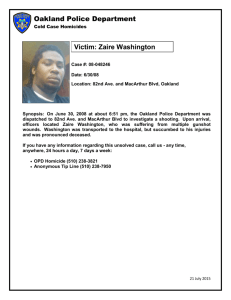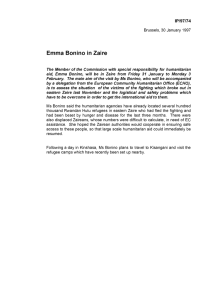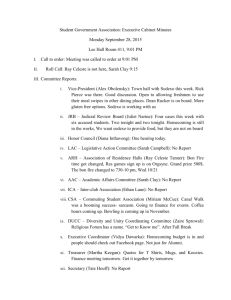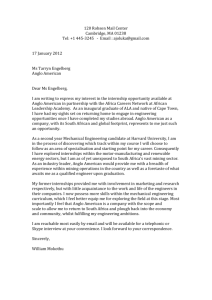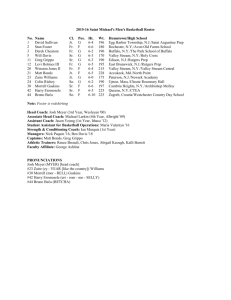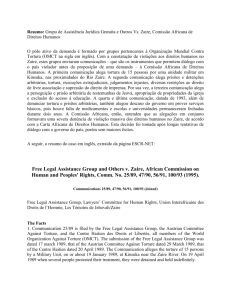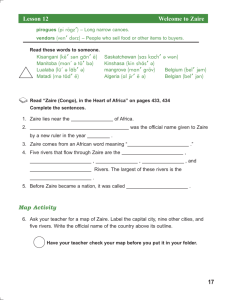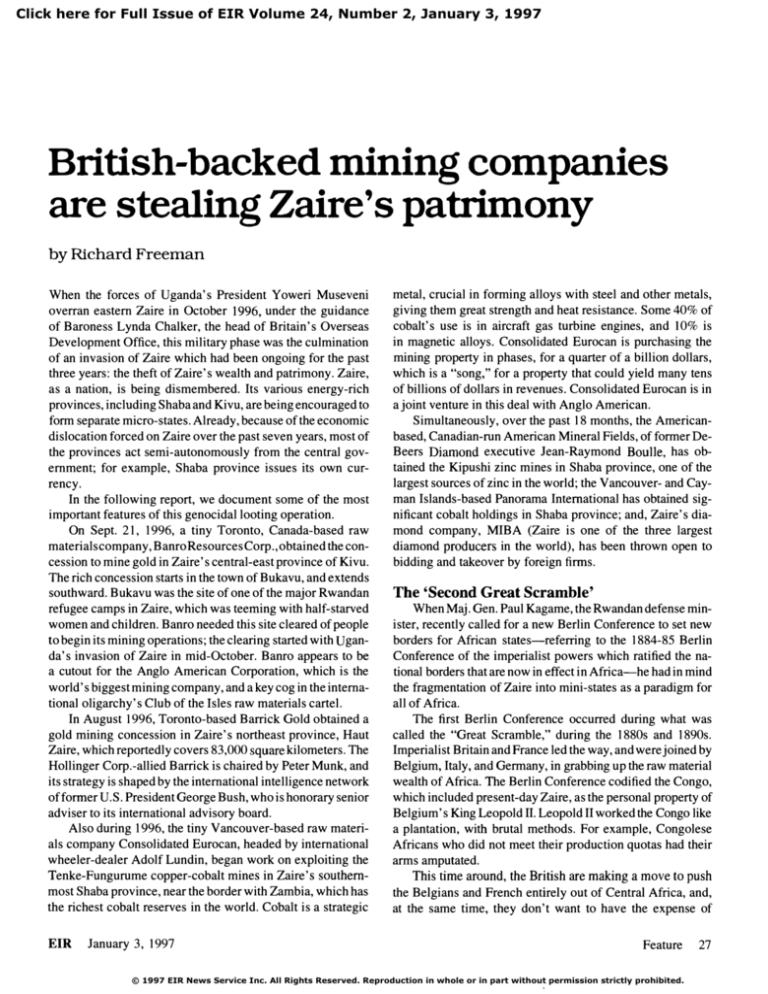
Click here for Full Issue of EIR Volume 24, Number 2, January 3, 1997
British-backed mining companies
are stealing Zaire's patrimony
by Richard Freeman
When the forces of Uganda's President Yoweri Museveni
metal, crucial in forming alloys with steel and other metals,
overran eastern Zaire in October 1996, under the guidance
giving them great strength and heat resistance. Some 40% of
of Baroness Lynda Chalker, the head of Britain's Overseas
cobalt's use is in aircraft gas turbine engines, and 10% is
Development Office, this military phase was the culmination
in magnetic alloys. Consolidated Eurocan is purchasing the
of an invasion of Zaire which had been ongoing for the past
mining property in phases, for a quarter of a billion dollars,
three years: the theft of Zaire's wealth and patrimony. Zaire,
which is a "song," for a property that could yield many tens
as a nation, is being dismembered. Its various energy-rich
of billions of dollars in revenues. Consolidated Eurocan is in
provinces, including Shaba and Kivu, are being encouraged to
a joint venture in this deal with Anglo American.
form separate micro-states. Already, because of the economic
Simultaneously, over the past 18 months, the American­
dislocation forced on Zaire over the past seven years, most of
based, Canadian-run American Mineral Fields, of former De­
the provinces act semi-autonomously from the central gov­
Beers Diamond executive Jean-Raymond Boulle, has ob­
ernment; for example, Shaba province issues its own cur­
tained the Kipushi zinc mines in Shaba province, one of the
rency.
largest sources of zinc in the world; the Vancouver- and Cay­
In the following report, we document some of the most
important features of this genocidal looting operation.
man Islands-based Panorama International has obtained sig­
nificant cobalt holdings in Shaba province; and, Zaire's dia­
On Sept. 21, 1996, a tiny Toronto, Canada-based raw
mond company, MIBA (Zaire is one of the three largest
materials company, Banro Resources Corp., obtained the con­
diamond producers in the world), has been thrown open to
cession to mine gold in Zaire's central-east province of Kivu.
bidding and takeover by foreign firms.
The rich concession starts in the town of Bukavu, and extends
southward. B ukavu was the site of one of the major Rwandan
The 'Second Great Scramble'
refugee camps in Zaire, which was teeming with half-starved
When Maj. Gen. Paul Kagame, the Rwandan defense min­
women and children. Banro needed this site cleared of people
ister, recently called for a new Berlin Conference to set new
to begin its mining operations; the clearing started with U gan­
borders for African states-referring to the 1884-85 Berlin
da's invasion of Zaire in mid-October. Banro appears to be
Conference of the imperialist powers which ratified the na­
a cutout for the Anglo American Corporation, which is the
tional borders that are now in effect in Africa-he had in mind
world's biggest mining company, and a key cog in the interna­
the fragmentation of Zaire into mini-states as a paradigm for
tional oligarchy's Club of the Isles raw materials cartel.
all of Africa.
In August 1996, Toronto-based Barrick Gold obtained a
The first Berlin Conference occurred during what was
gold mining concession in Zaire's northeast province, Haut
called the "Great Scramble," during the 1880s and 1890s.
Zaire, which reportedly covers 83,000 square kilometers. The
Imperialist Britain and France led the way, and were joined by
Hollinger Corp.-allied Barrick is chaired by Peter Munk, and
Belgium, Italy, and Germany, in grabbing up the raw material
its strategy is shaped by the international intelligence network
wealth of Africa. The Berlin Conference codified the Congo,
of former U.S. President George Bush, who is honorary senior
which included present-day Zaire, as the personal property of
adviser to its international advisory board.
Belgium's King Leopold II. Leopold II worked the Congo like
Also during 1996, the tiny Vancouver-based raw materi­
a plantation, with brutal methods. For example, Congolese
als company Consolidated Eurocan, headed by international
Africans who did not meet their production quotas had their
wheeler-dealer Adolf Lundin, began work on exploiting the
arms amputated.
Tenke-Fungurume copper-cobalt mines in Zaire's
southern­
This time around,
the Bri tis h
are making a move to pu sh
most Shaba province, near the border with Zambia, which has
the Belgians and French entirely out of Central Africa, and,
the richest cobalt reserves in the world. Cobalt is a strategic
at the same time, they don't want to have the expense of
EIR
January 3, 1997
Feature
© 1997 EIR News Service Inc. All Rights Reserved. Reproduction in whole or in part without permission strictly prohibited.
27
running a nation-state, an institution that they don't like any­
they took with them all their records and plans needed to
way. Rather, they deploy the companies of their global raw
mine."
materials cartel to buy up sections of a country. They keep
Despite difficulties, and while never enjoying true eco­
the people needed to run the mining and related enterprises
nomic developments that would have brought a decent stan­
alive at subsistence levels, and the rest of the population is
dard of li ving to Zaire's now 40 million people, Zaire nonethe­
treated as useless eaters, left to starve or be butchered.
less was able to harness and mine some of its immense raw
Driving the British actions this time, is another "Great
materials wealth. A sample of what Zaire accomplished can
Scramble." The international financier oligarchy, grouped
be gleaned from the report of the Minerals Yearbook, pub­
around the House of Windsor, knows that the world financial
lished by the Bureau of the Mines of the U.S. Department of
bubble-which they themselves created-cannot be sus­
Interior (Vol. III). In 1988, among the world's raw materials
tained, and will burst. They are getting out of paper financial
mining countries, Zaire held the following rank, for the fol­
instruments and into hard commodities: precious metals, such
lowing commodities:
as gold; strategic metals, such as cobalt and tantalum; base
metals, such as copper and zinc; energy supplies; and increas­
Cobalt
world's largest producer and exporter
ingly scarce food supplies. They want to either own the physi­
Diamonds
2nd in the world
cal assets, or, better still, own the mine production facility for
Copper
5th in the world
these assets. As the price of the hard commodity asset goes
Tin
12th in the world
up, the oligarchy makes super-profits. At the same time, they
Zinc
20th in the world
have finger-tip control over the minerals, food stuffs, and so
on upon which human life depends. They plan to exercise a
Zaire also mined other commodities, such as barite, bo­
food- and raw materials-control dictatorship in a post-col­
ron, magnesium, and gold. Because of historical ties, Zaire
lapse world.
shipped a good amount of these goods to Belgium. In the
The international oligarchy already owns extensive raw
1960s, in order to run its mining operations, Zaire created the
materials holdings. But they now seek to obtain those hold­
state-owned La Generale des Carrieres et des Mines du Zaire,
ings in Africa, Ibero-America, and Asia, which they don't
which is known by its acronym, Gecamines. One of its other
control.
important state-owned companies was based in Kivu prov­
Mineral-rich Zaire is in their target sights. Zaire's mineral
belt is located in the eastern and southern part of the country
ince, the Societe Miniere et Industrielle de Kivu, known by
its acronym Sominki.
(see Figure 1). It is a crystalline belt that runs alongside the
When Belgium granted Zaire independence, it be­
Great Rift, a geological fault running from the Jordan River
queathed to Zaire about $5 billion in debt, which Belgium
Valley in the Middle East, south through the Gulf of Aqaba,
had run up. By the late 1980s, Zaire's debt stood at about
through Central Africa (where Zaire is located), down to
$8 billion-a large debt for a small economy based on raw
southern Africa.
materials and food, but no manufacturing. Zaire got further
and further behind on its debt payments, and finally defaulted
IMF, World Bank, financiers cut off credit
on most of it in the early 1990s.
Most of Zaire's raw materials holdings are owned by the
This was the excuse that the banks wanted. They de­
state, and President Mobutu Sese Seko has resisted selling
manded that Zaire pay the debt, but also,joined by the World
them to foreigners. A seven-year campaign, including a total
Bank and others, demanded that Zaire "democratize" its gov­
credit and aid cutoff of Zaire, has been waged to force Mobutu
ernment and. especially, privatize its state-owned raw materi­
to give in. At the center of the campaign has been the Interna­
als mining concerns. Privatization had three components:
tional Monetary Fund (IMF), the World Bank, and the inter­
slashing the social services provided to miners by law, laying
national banks, which are run by the same oligarchical forces
off half the workforce at Gecamines, and selling more than
that run the global raw materials cartel.
half of the different properties of Gecamines and Sominki to
On June 29, 1960, Zaire obtained its independence from
foreign investors. Secessionist movements were started in
Belgium, although, as with many African countries, it was
Shaba province; the net effect would be to dismantle the Zair­
only a partial independence, because the countries were kept
ean state.
in economic backwardness. In the case of Zaire, in 1961, its
The banks organized an international credit cutoff, mean­
first elected President, Patrice Lumumba, was assassinated.
ing that Zaire could not get the money to purchase mining
Mobutu, who had been an Army general, was made President
machinery, spare parts, and other essential imports. The West
in 1965. In 1967, he declared that all the minerals in Zaire's
had always denied Zaire technology transfer, as long as the
subsoil belonged to Zaire, and nationalized the foreign mining
raw materials wealth was primarily in Zairean hands. Around
holdings, which meant principally Belgium's two all-power­
1993, the World Bank and IMF declared a credit cutoff to
ful companies, Union Miniere and Societe Generale. Accord­
Zaire. A senior source at the U.S. Geological Survey reported
ing to one source, "The Belgians were so angry at Zaire that
on Nov. 27, 1996, that the World Bank and its loan guarantee
28
Feature
EIR
January 3, 1997
FIGURE 2
Zaire's natural resources
I"Mm�
Ntil1mhc
KASAl REGION
!ntemaUonal boundary
CIij)ltal
City
Hr-Ir-tl RaH,oad
AM!(
Group 01 producing mines
o
Symbol
Au
Cb
Cd
Cem
Co
Cu
Q1
WIIIIII
� table tor mineral symbQI$.
Underli06d symbol indicates plant.
I
o
Source:
I
100
I
200
I
300
1
400 kllomeIeI'I
Mineral Industries of Africa, 1992 International Review,
Om
Mn
Pet
Re
Sn
Ta
W
Zn
Resource
Gold
Columbium
(niobium)
Cadmium
Cement
Cobalt
Copper
Diamond
Manganese
Petroleum
Rhenium
Tin
Tantalum
Tungsten
Zinc
Washington, D.C.:United States Department of the Interior, Bureau of Mines,
1994.
A gold mine in South
Africa. International
mining interests were in
the process of grabbing
up Zaire's strategic
mineral wealth, three
years before Zaire was
invaded by British­
backed military forces.
agency, the Multi-Lateral Investment Guarantee Corporation
infant death rate, more than 13 times that in the United States.
(MIGA), recommended to Zaire that it would not get new
In 1992, the last year for which figures were available,
money until it agreed to "modernize," that is, privatize, its
335,000 Zairean children under the age of five died. In 1994,
mining operations, by selling off sections of state holdings.
life expectancy in Zaire was 53 years, lower than in 1990.
At about the same time, the governments of Belgium,
Under this assault, President Mobutu opened the door to
France, and the United States cut off all official government
privatizing Zaire's patrimony, although still not at a rate fast
aid to Zaire.
enough to satisfy the World Bank vultures.
Currency warfare was unleashed in 1990, and has contin­
ued to this day. At one point, the Zairean currency, the zaire,
The corporate invasion
depreciated from a few new zaires to the dollar, to 3,250 to
At the heart of the invasion of Zaire's mining properties,
the dollar. This devaluation meant that Zaire earned almost
are the Canadian mining companies and the Oppenheimer
nothing for its foreign exports.
family-run Anglo American Corp., which often takes the
As the U.S. Geological Survey source explained, "The
Canadian companies under its wing in joint ventures. The
economy went down the tubes. Mining production today is
Canadian mining companies started an invasion of Zaire in
10% of what it was in the late 1980s. Because of the economic
1994, which reached a flood tide in 1996. This was the
dislocation, most of the provinces are operating on their own."
opening shot of the "Second Great Scramble." The Canadian
Indeed, between 1987 and 1993, cobalt production fell 82%,
mining companies represent forward beachheads for the
and copper production fell 90%. As a result, exports of miner­
Commonwealth-centered British Empire (see EIR Special
als and metals, which accounted for three-quarters of Zaire's
Report, May 24, 1996, "The Sun Never Sets on the New
foreign exchange earnings, dried up. Zaire's ability to service
British Empire"). Behind the companies, lurks the shadowy
the debt, should it choose to do so, disappeared.
presence of the Oppenheimer family's Anglo American
The conditions of life for the population worsened, in a
country in which living conditions were already bad. In 1990,
Corp., the linchpin of the Club of the Isles' raw materials
cartelization strategy.
only 39% ofZaireans had access to safe drinking water. Infra­
We look at three examples. First, the takeover of Somin­
structure is virtually nonexistent. In 1994, Zaire's infant mor­
ki, in Kivu province, by Toronto-based Banro Resource
tality rate was 111 deaths per 1,000 live births, i.e., an 11%
Corp.
30
Feature
EIR
January 3, 1997
Zaire has three eastern provinces: Haut Zaire, in the north­
east; Kivu, in the center-east; and Shaba (formerly Katanga),
government providing all the essential services/or the Kivu
Province" (emphasis added).
in the southeast. Kivu province is second in richness of raw
BanrolAnglo American effectively stole a good chunk of
materials, after Shaba. The leading mining concern in Kivu
the government of Kivu. This is the British model for the
is the Societe Miniere et Industrielle de Kivu, or Sominki.
Second Great Scramble. As a mining company, Sominki has
Sominki was formed in 1976 as an amalgamation of nine
its own explosives supplies and access to weapons, i.e., it has
companies that had been operating in Kivu province since the
the capability to carry out such an attack, or is in a command­
early 1900s. It operates 47 mining concessions, encompass­
ing position to influence, those who fired on the refugee
ing an area of 10,271 square kilometers.
camps.
In 1996, Banro Corp. of Toronto bought 36% of Sominki,
The second example, is that of American Mineral Fields
raising some of its money for the purchase by floating shares
(AMF), which is based in Hope, Arkansas, but run from Can­
in Singapore. Banro was previously a small financial institu­
ada. AMF has acquired from Gecamines the Kipushi copper­
tion, with little apparent aptitude for mining. The impression
zinc mine, one of the world's premier copper-zinc mines,
is that it was reconfigured as a company for the special pur­
located in Shaba province (copper and zinc are often mined
pose of this purchase, perhaps acting as a front for someone.
together). The Belgians developed Kipushi and began mining
(Who that someone is, will become clear.)
Another large chunk of Sominki was bought by the Bel­
in 1925. At its peak in 1988, the Kipushi mine produced
143,000 tons of zinc, and 43,000 tons of copper. Its total
gium-based company Mines D'or du Zaire, or MDDZ. Own­
known and probable reserves stand at 22.6 million tons, grad­
ing 60% of MDDZ is Cluff Mining Co. of London, and con­
ing 2.1% copper and 13.8% zinc.
trolling 65% of Cluff is Anglo American Corp., the world's
AMF is the brainchild of its owner, Jean-Raymond
largest mining company and a key component of the Club of
Boulle, a former executive for DeBeer's Diamonds. In tum,
the Isles.
AMF signed an agreement with Anglo American, which
On Sept. 21, 1996, Banro and MDDZ announced their
allows Anglo American to invest up to $100 million in any
merger, with Banro selling its shares to MDDZ. The new
AMF venture in Shaba province, representing up to a 50%
Banro-MDDZ company consolidated a 72% stake in Somin­
equity stake in the venture, including the Kipushi mine. Once
ki, while the government of Zaire holds 28%. The Banro­
again, ubiquitous Anglo American shows up.
MDDZ entity has announced that it plans to acquire that 28%
The third example, is that of tiny Consolidated Eurocan
from the government. The overall enterprise is essentially a
of Vancouver. In 1996, Eurocan finalized a deal that will
vehicle for Anglo American.
allow it to purchase from the state mining company Geca­
According to various Banro corporate reports and news
mines, a 55% interest in the Tenke-Fungurume copper-cobalt
releases, Banro was anxious to get its mining operations
deposits. Eurocan will pay a quarter of a billion dollars over
started as quickly as possible. However, the Sominki mining
72 months for its stake, but the stake is worth potentially tens
zone that Banro acquired started in the town of Bukavu, the
of billions of dollars in revenues. According to a Eurocan
center for the major camp for Rwandan refugees who had fled
spokesman on Dec. 18, Tenke-Fungurume, located in Shaba
to Zaire, with nearly a million people. To get mining started,
province, represents the largest operating cobalt reserves in
the entire zone would require clearing. Suddenly, as Uganda
the world. It has geological reserves of 222 million tons of
launched its invasion of eastern Zaire, near Bukavu, in mid­
copper and cobalt, with potential reserves of I billion tons.
October, there was firing on the Bukavu refugee camp, sup­
Consolidated Eurocan is owned and run by Canadian
posedly against "Hutu rebels" who were hiding there. The
wheeler-dealer Adolf Lundin. One U.S. mining source re­
military attack on the camp forced hundreds of thousands of
ported, "There is no way that Eurocan can develop the mines
refugees to flee Kivu province, back to Rwanda. But, who did
on its own. It doesn't have the capabilities. It will have to sell
the firing? While a clear answer is not forthcoming, it may
off shares to established mining companies, most likely Iskor
have involved portions of the newly acquired Sominki appa­
and Gencor, to work the properties." Iskor and Gencor are
ratus itself. For, in acquiring Sominki, Banro did not just
both South African companies, and part of the British raw
acquire a company; it acquired the effective governmental
materials cartel.
structure of the entire Kivu province.
According to a Banro corporate press release, "Sominki
owns an extensive infrastructure which includes repair shops,
Thus, these Canadian companies, in some cases stalking
horses for Anglo American, are gobbling up Zaire's gold,
copper, zinc, and cobalt reserves.
machine shops, electrical shops and a large fleet of Land Ro­
Add to this, the Barrick Gold purchase of a huge conces­
ver vehicles. In addition, it operates six hydroelectric sites, a
sion in Haut Zaire, and the fact that there is now discussion
number of air strips, and 1,000 kilometers of roads. Sominki
of opening up the major government-owned diamond mining
is virtually self-sufficient. The company has about 5,000 em­
company, Societe Miniere de Bakwanga (MIBA), to foreign
ployees." The release added, "In fact, Sominki is the de/acto
investors. MIBA accounts for 40% of Zaire's official dia-
EIR
January 3, 1997
Feature
31
mond exports. The remaining 60% are developed by artisanal
miners, i.e., prospectors, who then sell the gems to "Israeli
diamond buyers and to [international gem dealerJ Maurice
Templesman," according to a knowledgeable source. The
Belgian-born Tempelsman, who squired around Jacqueline
Kennedy Onassis before she died, is an international tycoon.
He is fonner president of the U.S. Africa Society, a group
that is influential in the shaping of U.S. government Af­
rica policy.
The Anglo American paradigm
Anglo American Corp. offers a foretaste of how a world
without nation-states, run by the financier oligarchs, would
operate. It was formed in 1917. Financing for, and invest­
ments into Anglo American and its associated companies,
came from the Rothschild bank and J.P. Morgan. The South
Africa-based Anglo American, through cross-ownership
shares, owns DeBeers Centenary and DeBeers Consolidated
(which together control the Central Selling Organization, that
markets and controls 80% of the world's diamonds), and the
TABLE
1
Anglo-American and Rio Tinto Zinc combined
share of Western world mining production
(percent of total)
Commodity
Share
Commodity
Share
8%
Antimony
20%
Nickel
Bauxite
10
Niobium
Chromite
15
Palladium
39
8
Cobalt
10
Platinum
45
Copper
12
Rhodium
41
Diamond
48
Silver
Gold
25
Titanium
31
Iron are
10
Tungsten
18
6
Lead
7
Uranium
Lithium
5
Vanadium
6
Zinc
Manganese
Molybdenum
11
8
36
6
Zirconium
23
Luxembourg-based Minerals and Resources Corp. (Minorco)
mineral holding company. In South Africa alone, Anglo
American owns more than 1,600 companies. where it is the
put its worth at more than $1 trillion. According to one
world's leading gold producer, the world's leading platinum
report, Anglo American is trying to buy what remains of
producer, the world's leading diamond producer, and much
Zaire's Gecamines, after everything else has been sold off.
But the full global reach of Anglo American only becomes
else.
The Oppenheimer family runs the Anglo American Corp.
clear when viewed in conjunction with the holdings of the
empire. Cambridge University-educated Harold Oppenhei­
London-based Rio Tinto Zinc (RTZ), the world's second
mer was chairman until 1982, and still reportedly makes all
largest raw materials producing company. RTZ was formed
important decisions. His son Nicholas is the leading family
in the 1 870s by China opium trader Hugh Matheson, who was
member in the company. The Oppenheimer family members
a principal in the Hongkong-based firm Jardine Matheson.
are in the 100 I Club, the tightly knit, elite society that brings
The Rothschilds have a significant stake in the company.
together oligarchs, financiers, raw materials company execu­
Queen Elizabeth II is also a significant investor in RTZ. Anglo
tives, and billionaires to coordinate strategy worldwide. Bar­
American and RTZ combined control a stunning percentage
rick Gold chairman Peter Munk is a member of the Club, as
of the Western world's most important raw materials (see
are many other heads of the world's top mining companies.
Table 1).
The Club is closely intertwined with the World Wide Fund
for Nature of Britain's Prince Philip.
Though the Oppenheimers publicly professed to be critics
The Anglo American-RTZ combination anchors the
House of Windsor's raw materials cartel. EIR showed in its
Sept. 15, 1995 issue, that the House of Windsor cartel con­
of South African apartheid, they fundamentally supported
trols, overall, 59.5% of world gold production, 78% of world
and benefitted mightily from its existence, which allowed
platinum production, 25% of copper, 55% of alumina bauxite,
them to run their mines as slave-labor plantations.
64% of cobalt, 42% of manganese, 39% of chromium, and
But the Anglo American Corp. empire extends to every
so on.
mineral-producing country in Africa and the world, and it
Thus, Anglo American Corp. and the Canadian compa­
continues to grow. In October 1996, Anglo upped to 26%
nies integrated into the process of taking over Zaire, are out
its ownership stake in the London-headquartered, Zimbabwe
to extend the power of the raw materials cartel. If they suc­
(formerly Rhodesia)-centered Lonrho raw materials com­
ceed, there will be no nation-state: Only a portion of the popu­
pany, which had been run by Tiny Rowland. In tum, Lonrho
lation, that permitted to slave for the mining companies' oper­
owns a 30% ownership stake in the Ashanti Mines in Ghana,
ations, will remain; the rest will be written off. As is shown
which represents the richest operating goldfield outside of
by the treatment of the Rwandan refugees in Kivu province,
South Africa. Anglo American has been trying to purchase
who were either starved, butchered, or simply moved away
the state-owned CVRD company of Brazil, which controls
to make way for mineral production, the mining companies
the Gran Carajas mining project in Brazil. With everything
do not care about human lives, only about their profits and
from iron and copper to precious minerals, some estimates
their geopolitical control.
32
Feature
EIR
January 3, 1997

